The Huntington Library, Art Museum, and Botanical Gardens is a collections-based research and educational institution serving scholars and the general public. Find out more about The Huntington on our website and at Verso, our blog.
Don't wanna be here? Send us removal request.
Photo


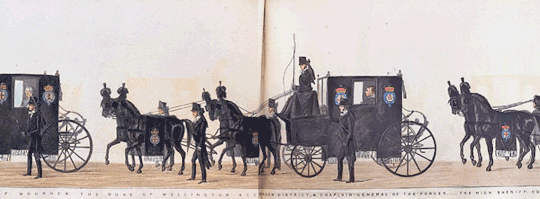
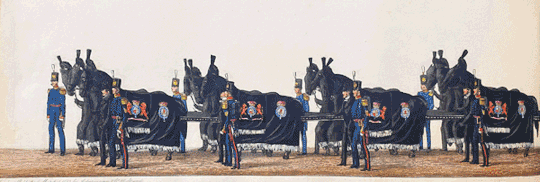
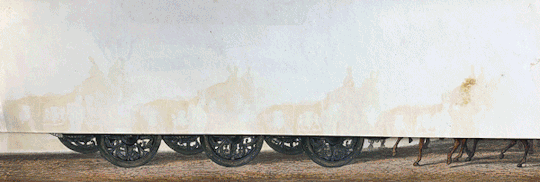

Well guys, welcome to our final Huntington Tumblr post (RIP).
These past seven years, we’ve laughed, we’ve cried—we’ve had the time of our lives being a part of this weird and wonderful community. This may be our final post, but there are still plenty of amazing stories that will remain in our archive to explore. Here are a few we recommend:
Octavia E. Butler papers
Corpse Flower at The Huntington
Preservation Week
Portrait Power Rankings
Huntington Art Gallery
Library Exhibition Hall
Scott Galleries
Botanical Gardens
Please keep in touch with us elsewhere on the interwebs! We’re on Instagram, Facebook, and Twitter.
Henry Gordon Alken, The funeral procession of Arthur Duke of Wellington, hand-colored panoramic view, twenty-eight double leaves joined and folded accordion fashion. Dated March 1, 1853. Includes one admission ticket to the funeral (for “a lady”). Select pages gif’d by The Huntington.
89 notes
·
View notes
Text
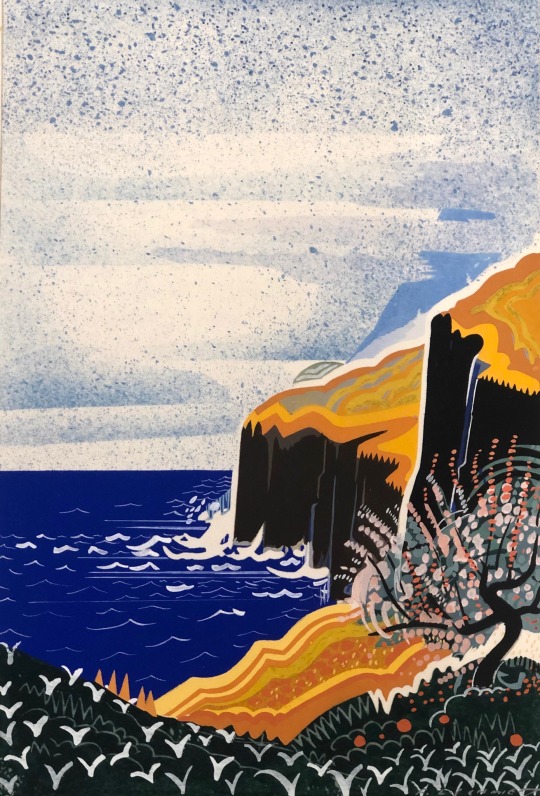


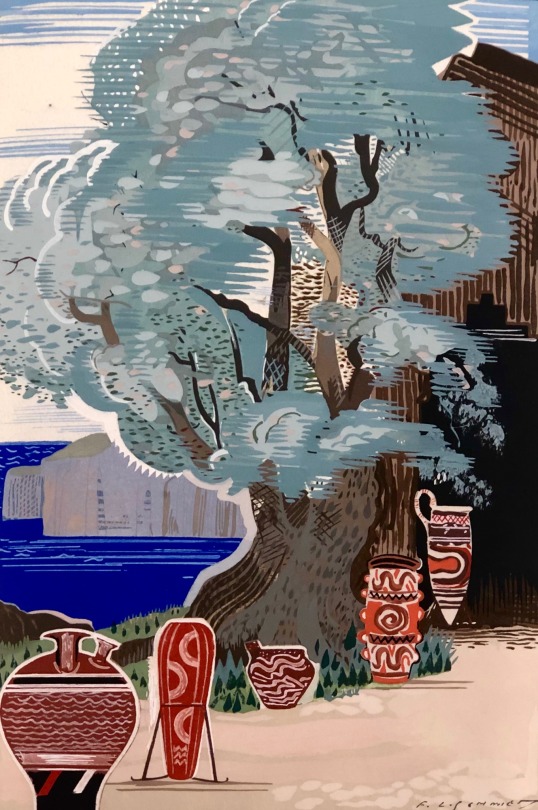
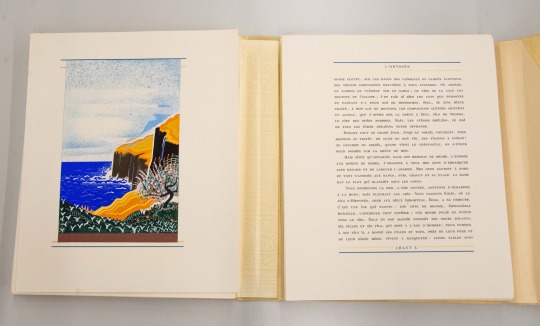
Illustrations from a 1933 French edition of Homer’s “Odyssey” from our library collections. The artist, François-Louis Schmied, first painted the compositions before they were reproduced into woodcuts and colored.
528 notes
·
View notes
Photo


Both artist and art critic, John Ruskin was acknowledged as one of the 19th century's greatest geniuses; but towards the end of his career, his work fell into obscurity. A conference at The Huntington this weekend makes the case for his enduring relevance and importance.
More over on Verso...
64 notes
·
View notes
Text
Beside the Edge of the World

Opening this Saturday, Nov. 9: exhibition Beside the Edge of the World began with a treasured book in The Huntington’s collections: a first edition of Thomas More’s Utopia, printed in 1516. This 500-year-old text served as a jumping-off point for the fourth year of /five, The Huntington’s contemporary arts initiative, in partnership with Los Angeles arts organization Clockshop.
Three artists and two writers were invited to consider More’s classic work as they explored The Huntington’s collections. The process of discovery started with ideas of mapping borders and edges, temporarily forgotten histories, peoples whose lives had been carefully recorded—and then forgotten—and utopian experiments in communal living. Many of these places and the people who challenged the dominant narratives of history existed on the periphery.
Read more about each project below:

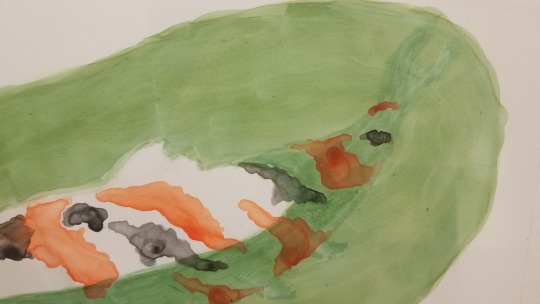
Artist Nina Katchadourian’s work Strange Creature was inspired by The Huntington’s collection of sixteenth- and seventeenth-century maps and books, as well as the ancient Chinese mythological text Shan Hai Jing (Guideways through Mountains and Seas). The myriad of creatures depicted in these ancient texts offered a challenge: How much have we really seen of the world, and how well do we know it? Katchadourian imagined a creature, somewhat familiar but also strange, slowly surfacing from our own Chinese Garden’s Lake of Reflected Fragrance. Her installation suggests that there is more around us than we can see or perceive—literally, and perhaps also in an otherworldly sense. See if you can catch a glimpse of her creation in the Chinese Garden.

Writer Robin Coste Lewis was inspired by a particular passage in Henry David Thoreau's canonical Walden; or, Life in the Woods. In a chapter titled “Former Inhabitants; and Winter Visitors,” Thoreau describes the community of free Blacks that had been living around Walden Pond long before Thoreau arrived. For Lewis, this passage contained a hidden call to the rediscovery of African American histories woven into the story of Concord, Massachusetts, and hence, America. In order to extend Thoreau’s experiment, she omitted much of the chapter’s text and rearranged the remaining lines to emphasize, lyrically, the free Black community that had once called the woods home.

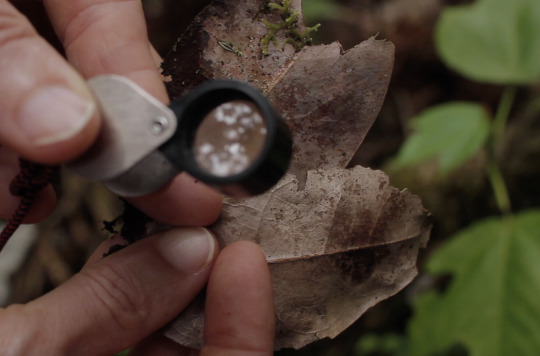
Artist Beatriz Santiago Muñoz’s film Laurel Sabino y Jagüilla takes its title from a species native to the artist’s birthplace and home on the island of Puerto Rico, a flowering plant now endangered by logging and wood harvesting. Magnolia is an ancient genus, dating back 20 million years; its family, Magnoliaceae, has survived ice ages, mountain formation, and continental drift. Filmed in the rain forest of Puerto Rico and in the gardens of The Huntington, the work imagines the relationship of Magnolia splendens to utopia, photography, soil, vision, and time.
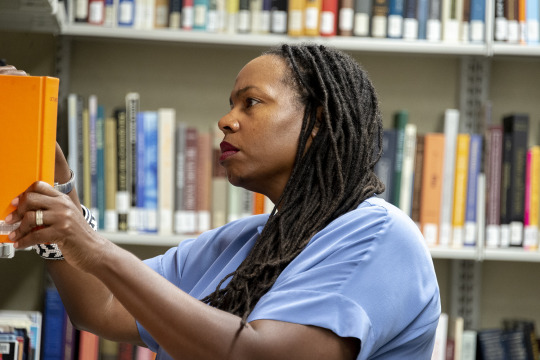
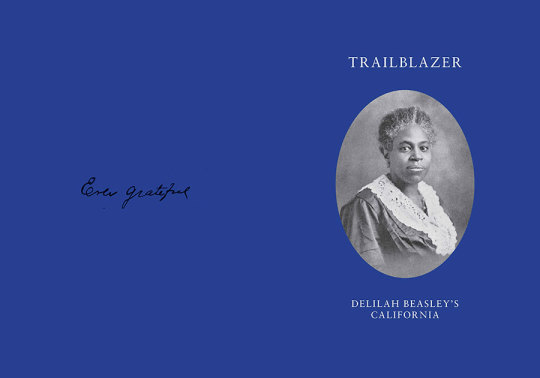
Writer Dana Johnson’s short story Our Endless Ongoing reimagines the life of Delilah Beasley in early twentieth-century California. Delilah Leontium Beasley (1871–1934), an American historian and columnist for the Oakland Tribune, was one of the first African American women to be published regularly in a major metropolitan newspaper. She also became the first person to document the overlooked but significant history of California’s Black pioneers, in her book The Negro Trail-Blazers of California (1919), published the same year as the founding of The Huntington.


Artist Rosten Woo created Another World Lies Beyond as a series of interrelated stories told through audio, projection, and artifact, installed in the gallery and in the gardens to invite contemplation and political reflection. The narrative through-line is the life and work of Robert V. Hine (1921–2015), a scholar of California utopian communities whose papers are housed at The Huntington. Each audio story offers a glimpse of an idea of the perfect state and the world just beyond it. Additionally, a short animated film by Woo brings together all the illustrations from John Russell Bartlett’s failed 1857 survey of the U.S.–Mexico border, included in the Report on the United States and Mexican Boundary Survey.
images:
Nina Katchadourian looks at maps from Theatrum Orbis Terrarum (Theatre of the World) by Abraham Ortelius, ca. 1606. Photo by Kate Lain.
Nina Katchadourian (b. 1968), Study for “Strange Creature,” 2019. Watercolor, pencil, gouache on paper. Courtesy of the artist, Catharine Clark Gallery, and Pace Gallery.
Robin Coste Lewis (b. 1964), excerpt from poetry chapbook Inhabitants and Visitors, Los Angeles, Clockshop, 2019.
Beatriz Santiago Muñoz filming in The Huntington’s gardens. The Huntington. Photo by Kate Lain.
Beatriz Santiago Muñoz (b. 1972), film still from Laurel Sabino y Jagüilla, 2019. Courtesy of the artist.
Dana Johnson at The Huntington. Photo by Kate Lain.
Dana Johnson (b. 1967), “Our Endless Ongoing” featured in Trailblazer: Delilah Beasley’s California, Los Angeles, Clockshop, 2019.
Rosten Woo at The Huntington. Photo by Kate Lain.
Rosten Woo (b. 1977), excerpt from Another World Lies Beyond, 2019.
Support for this exhibition is provided by the Mike Kelley Foundation for the Arts, the Philip and Muriel Berman Foundation, the Pasadena Art Alliance, and WHH Foundation.
Beside the Edge of the World is a Huntington Centennial Exhibition. The Huntington’s Centennial Celebration is made possible by the generous support of Avery and Andrew Barth, Terri and Jerry Kohl, and Lisa and Tim Sloan.
#5atTheH#100atTheH#Utopia#Thomas More#Nina Katchadourian#Robin Coste Lewis#Beatriz Santiago Muñoz#Dana Johnson#Rosten Woo#contemporary art#library#art#botanical
34 notes
·
View notes
Photo



The #ProjectBlueBoy gallery experience is almost complete. For the last few months, conservator Christina O'Connell has been working on inpainting, a process in which new conservation colors are added to areas where the original paint is lost or missing.
As part of the ethics involved in the profession, any paint added by the conservator is easily reversible and separated from the original surface of the painting by a layer of new varnish; and the conservation colors added during inpainting are carefully mixed to match in color, texture, and transparency.
To see the delicate process in person, stop by this Thursday for the final day of scheduled conservation work in the gallery. Starting Oct. 1, Blue Boy will be off view and in the conservation lab for final analysis and inpainting. More details here: https://www.huntington.org/project-blue-boy
92 notes
·
View notes
Photo





"In looking through the collection, I was interested in boundaries, including political boundaries, and the kinds of practical and theoretical problems they bring up...For a good 50 years after the U.S.-Mexico boundary was drawn, they had to redraw the line every three years and set markers along it, though now it’s pretty clearly delineated and militarized. So, it’s really easy to draw the line but really complicated to make it mean something."
Read more from Rosten Woo, one of our 2019 #5atTheH artists, as he examines ideas of perfection through the lens of Thomas More's "Utopia," early utopian settlements in California, and drawings from an expedition marking the U.S.-Mexico border.
One of Woo’s contribution’s to the upcoming /five exhibition, “Utopia In Out Over Through,” consists of five audio tours that bridge The Huntington’s garden and gallery and focus on the archive of historian Robert Hine. Rosten’s audio tour takes listeners through stories from Hine’s research: to the U.S.-Mexico border; to Kaweah Colony, a utopian commune in Northern California; and into the Chinese Garden.
More on Verso: http://bit.ly/2lNfvjg
27 notes
·
View notes
Photo








Did you know some books contain hidden images? Fore-edge painting, or decorating the closed leaves of a book, first began in the 11th century; but it wasn’t until the 17th century that the practice of a "disappearing” fore-edged painting began. Artists painted the inside edges of a book’s pages so that the image would only be seen when the pages were fanned in a certain direction. Above are some lovely examples found in our library archives.
images:
[1-4] Dante Alighieri (1265-1321), “The Divine Comedy,” 1854. London: Chapman and Hall. The Huntington Library, Art Collections, and Botanical Gardens.
[5] William Falconer (1732-1769), “The Poetical Works of William Falconer,” 1836. London: William Pickering. The Huntington Library, Art Collections, and Botanical Gardens.
[6-7] John Milton (1608-1674), “Paradise Lost,” 1776. Glasgow: Printed by Robert and Andrew Foulis printers to the University. The Huntington Library, Art Collections, and Botanical Gardens.
[8] View of all three books closed, without the hidden illustrations visible. The Huntington Library, Art Collections, and Botanical Gardens.
#National Book Lovers Day#NationalBookLoversDay#Fore-edge painting#fore-edge books#Dante#Divine Comedy#Milton#Paradise Lost#William Falconer#art#library
364 notes
·
View notes
Photo
We thought it was important to remind you that this exists.
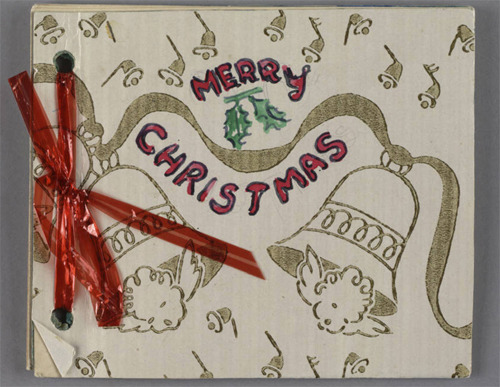

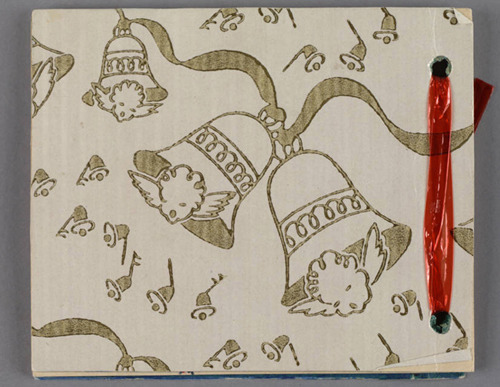
MERRY CATMAS!!!
Astronomer Edwin Hubble and his wife, Grace, had an adorable cat. And so their friends Alfred and Maxine Parish made them the above little book, The Life and Times of Nicolas Hubble, Esq., Photograph album of Edwin Hubble’s cat, Nicolas Copernicus.
It’s pretty much the cutest thing in the entire world AND IT’S IN OUR LIBRARY.
(You can read more about how much the Hubbles loved their cat—and see Edwin and Nicolas sitting with an armillary sphere and an orrery—on Verso.)
141 notes
·
View notes
Photo


Today marks the 106th wedding anniversary of Henry and Arabella Huntington, married in Paris #onthisday in 1913. Of the marriage, Henry wrote to his sister saying, “I cannot tell you how happy I am, my dear Sister and I hope to make up for all I have lost and again have a home, and a home such as I never had. Belle is so good and kind to me, and I know she will make my life very happy.”
35 notes
·
View notes
Text

Happy Fourth of July! The Huntington is closed today, and will reopen tomorrow, July 5th. In the meantime, enjoy this beautiful lithograph from our art archives, "July 4th, 1936" by Kyra Markham.
30 notes
·
View notes
Text
Project Blue Boy: Phase 2
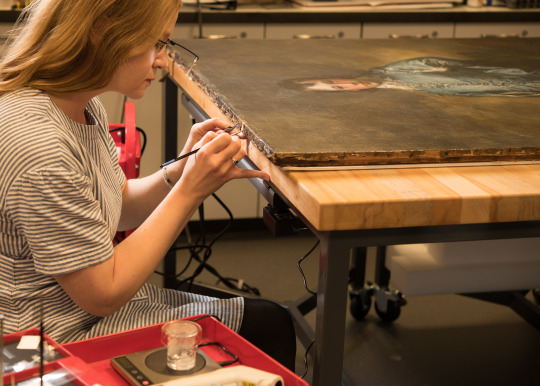
After a stay in the conservation lab for some delicate repairs to the painting's canvas lining, Phase 2 of #ProjectBlueBoy is complete! Here’s a closer look at some of the treatments Blue Boy underwent:
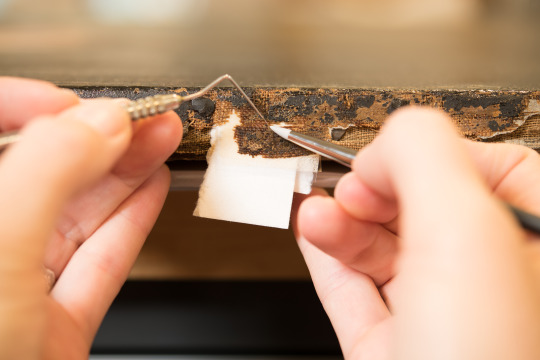
To repair the torn and fragile areas of the tacking edges of the canvas, conservator Christina O’Connell carefully realigned the tiny frayed and torn threads. This type of thread by thread mend honors the original structure of the canvas.
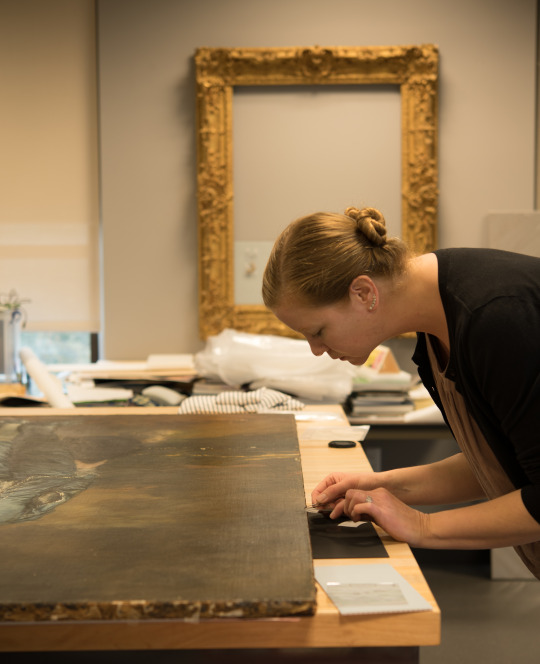
To reattach portions where the original canvas was separating from the support lining, O’Connell added adhesive between the layers. Work was also done to repair cracks and splits found in the wooden stretcher.

Before moving back into the gallery, O’Connell took photographs of Blue Boy, as written and photographic documentation are an important part of the conservation process.
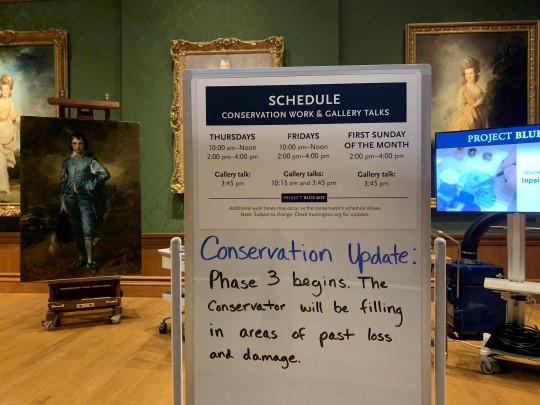
Next up: Inpainting in the gallery! O’Connell will be reintegrating areas of past loss and damage to the painting during Phase 3. For more details on the project and to see the in-gallery conservation schedule, check out huntington.org/projectblueboy.
144 notes
·
View notes
Photo


Have you ever wondered what happens to the ripe, luscious oranges you see growing in The Huntington's orchards? Thanks to our friends at Food Forward, they don't go to waste. Since 2012, the group has harvested more than 170,000 pounds of Huntington fruit—including oranges, lemons and persimmons—to feed those in need.
More over on Verso...
38 notes
·
View notes
Photo

Get ready to party. Starting Sept. 5, we'll be launching a yearlong series of centennial festivities in honor of our 100th birthday. Here are few of the ways we’ll be celebrating, in no particular order:

For the first time in 50 YEARS, we’ll have a float in the 2020 Rose Parade.

Our massive exhibition highlighting 1919, the year of our founding, opens Sept. 21, 2019. “Nineteen Nineteen” will feature around 275 objects from The Huntington’s holdings, each created, edited, acquired, or published in the year 1919.

A new rose has been created especially for our centennial, named “Huntington’s 100th.’ The bloom produces pink then yellow petals and smells amazing (like fruity lemon blossoms).
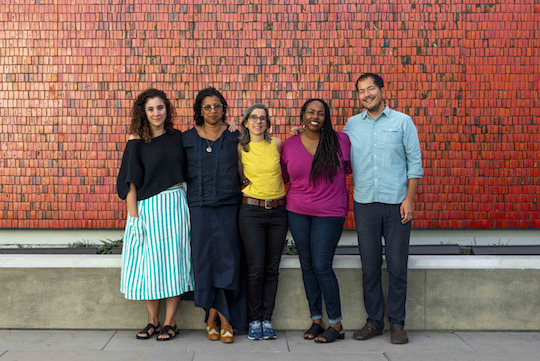
Exhibition “Utopia” [working title] will open Nov. 10, in collaboration with Los Angeles arts organization Clockshop (part of The Huntington's contemporary arts initiative /five.) See new works by artists Nina Katchadourian, Beatriz Santiago Muñoz, and Rosten Woo and writers Dana Johnson and Robin Coste Lewis, Poet Laureate for the City of Los Angeles. Each participant is investigating ideas of perfection and utopia using Thomas More's satirical work Utopia (1516) as a foundational text and starting point.
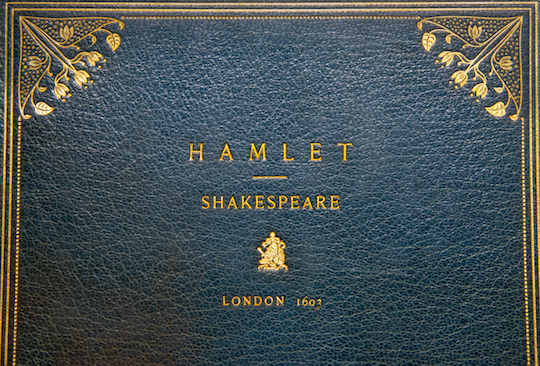
A program part of the President’s Series will feature actors from the Independent Shakespeare Co. of Los Angeles reading and comparing portions of the so-called “bad quarto” of Hamlet with the version audiences are familiar with. Zachary Lesser, professor of English at the University of Pennsylvania, will provide commentary.
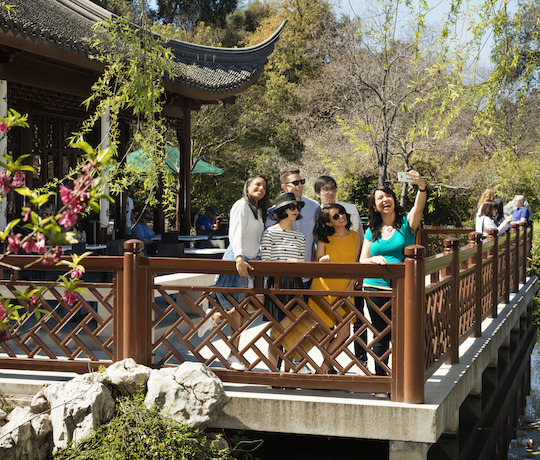
Launching Sept. 6, we’ll be giving away 100 Memberships to the first 100 Los Angeles County college students who apply (!!!!!!!). Students may enter by sending an email to [email protected] on or after Sept. 6, 2019.
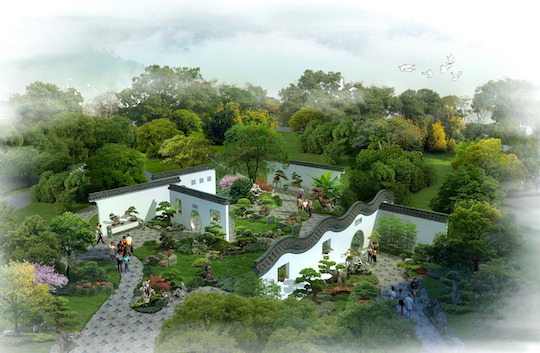
The Chinese Garden expansion, featuring a new art gallery, restaurant, and more, will reopen in spring 2020. GET READY.
For more upcoming centennial programs, events, exhibits, and activities, go here
images:
The Huntington's 1969 Rose Parade® float, sponsored by the city of San Marino, Calif. The Huntington.
Cover of Nineteen Nineteen (2019) catalog by James Glisson and Jennifer Watts; Portrait of Henry E. Huntington on Loggia of San Marino Residence, April 1919. The Huntington.
‘Huntington's Hundredth' commemorative rose. Photo courtesy of Weeks Roses.
Beatriz Santiago Muñoz, Robin Coste Lewis, Nina Katchadourian, Dana Johnson, and Rosten Woo. Photo: Kate Lain
William Shakespeare (1564-1616), Hamlet (1603). The Huntington.
Visitors in the Chinese Garden at The Huntington. Photo by Piper Ferguson.
Artist rendering of the penjing garden, one of the new features being built for the final phase of the Chinese Garden’s construction. The Huntington.
#100atTheH#centennial#rose#Rose Parade#Rose Parade 2020#Nineteen Nineteen#Utopia#ClockshopLA#5atTheH#Beatriz Santiago Muñoz#Robin Coste Lewis#Nina Katchadourian#Rosten Woo#Shakespeare#Hamlet#Chinese Garden#FREE STUFF
52 notes
·
View notes
Text
Just some weird & wonderful plants doing cool stuff:


A native of Australia, fiery red blooms emerge from this Eucalyptus macrocarpa after its tiny pointed cap (known as a calyx) pops off. See it blooming in the Australia Garden.



You can’t miss the brilliant turquoise flowers and hot pink stalks produced by the Puya—see three different varieties ( Puya alpestris, Puya venusta, and Puya coerulea var. violacea) blooming now in the Desert Garden.



Did you know that cool spring weather can affect the shape of rose petals? In varieties like ‘Mellow Yellow’ and ‘Easy Does It II,’ found in our Rose Garden, the flowers produce frilly petals only during the first bloom cycle of early spring.

Chorisia insignis, also known as the silk floss tree, palo borracho, samu'ũ, paineira, or toborochi, is native to Argentina and part of the baobab family. After flowering in the winter, it disperses seeds within balls of fluffy, fibrous matter, similar to wool or cotton. See it fluffing near the Huntington Art Gallery.
#botanical#roses#Rose Garden#Australian Garden#Eucalyptus macrocarpa#puya#Desert Garden#silk floss tree#Huntington Art Gallery#atTheH#blooms
618 notes
·
View notes
Photo

Coming this fall: a massive centennial exhibition centered on 1919, the year of our founding.
A tumultuous time in our nation's history, "Nineteen Nineteen" will tell the story of a year in which soldiers returned from World War I, African Americans faced violence during the “Red Summer,” women fought for the right to vote, and cripplingly high inflation sparked labor unrest.
The show will feature approximately 275 objects from across The Huntington's collections, each made, published, edited, exhibited, or acquired in 1919.
Read more about the upcoming exhibition here
image:
Nineteen Nineteen (2019) by James Glisson and Jennifer Watts. Book to complement the exhibition. Published by The Huntington Library, Art Collections, and Botanical Gardens. Available Aug. 21, 2019.
43 notes
·
View notes
Photo






Didn’t watch #GameOfThrones but kinda want to know what happened? This 16th-century alchemical scroll from our collections pretty much sums it up.
#GameofThrones#GOT#breakthewheel#house stark#house lannister#house targaryen#house baratheon#house tarly#other houses#white walkers#dragons#ice and fire#imagine another eye on the chicken man#boom three-eyed raven#mother of dragons#fall of the mother of dragons#everything ends with a book
74 notes
·
View notes
Photo


On this day in 1869, the eastbound and westbound railroad tracks met at Utah's Promontory Summit, marking the completion of the Transcontinental Railroad. Though it remains a monumental moment in history, many Americans felt the railroad created a new empire, ruled by "masters of the iron horse rather than the people."
More over on Verso...
34 notes
·
View notes